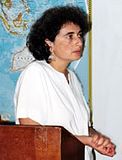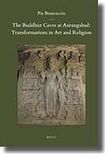The Buddhist Caves at Aurangabad
Brancaccio, Pia:
The Buddhist Caves at Aurangabad : transformations in Art and Religion / Pia Brancaccio. - Leiden [u.a.] : Brill, 2011. - 300 S. : Ill. - (Brill's Indological Library ; 34)
ISBN 978-90-04-18525-8
EUR 108,00 / US$ 154,00
DDC: 726.143; 704.948943095479
Beschreibung
This is a study that focuses on the art and architecture of a group of Buddhist rock-cut monuments excavated on the western edge of the Deccan Plateau in India. It analyses the various cultural, historical and religious phenomena that shaped the caves at Aurangabad through the first seven centuries of the Common Era and it comments on the Buddhist tradition of the western Deccan as a whole. The result is a comprehensive work that does not address exclusively iconography and chronology, but looks beyond Aurangabad to the larger artistic and religious traditions of the Indian Subcontinent. [Verlagsinformation]
Inhalt
List of Illustrations. xi
Acknowledgments. xix
Introduction: Why Aurangabad. 1
CHAPTER ONE: THE CAVES. 7
1.1 The Western Group of Caves. 8
1.2 The Eastern Group of Caves. 16
1.3 The Northern Cluster of Caves at Aurangabad. 24
CHAPTER TWO: THE BEGINNINGS AT AURANGABAD 25
2.1 Establishing a Chronology. 25
2.2 Methodological Problems in Dating the Early Caves in Western Deccan. 28
2.3 Defining Micro- Regions: The Relevance of Physical and Cultural Geography. 31
2.4 Regional Trends in Cave Architecture. 34
2.5 Archaism. 36
2.6 Ihe Ajanta Cluster in the Upper Plateau Region: Locating the Aurangabad Caitya. 37
2.7 Ihe Stūpa. 40
2.8 Relics in Rock-cut Stūpas: Caityas vs. Stūpas. 43
2.9 The Vihāra at Aurangabad: Missing Evidence. 52
2.10 The Aurangabad Caves and the Ajanta Cluster: Agriculture, Trade, and Patronage Between the Sātavāhanas and the Kṣatrapas. 57
CHAPTER THREE: THE AURANGABAD RENAISSANCE IN THE FIFTH CENTURY. 71
3.1 The Hiatus. 71
3.2 International Trade and the Elite Patronage of Buddhist Caves at the End of the Fifth Century CE. 80
3.3 The Rebirth of Patronage at Aurangabad: Cave 3. 88
3.4 The Sculpture at Aurangabad: Outdoing the Models. 91
3.5 Aurangabad and the Gupta-Vākāṭaka Idiom. 98
3.6 Aurangabad and the Northwest of the Indian Subcontinent. 101
3.7 The Buddha in the Monasteries at Aurangabad and Ajanta. 108
3.8 Mahayana at Aurangabad. 115
3.9 The Diffusion of Mahāyana at Kanheri: A Coastal Phenomenon? 120
CHAPTER FOUR: BUDDHIST PRACTICE AT AURANGABAD IN THE SIXTH CENTURY 125
4.1 Cave 2 at Aurangabad: Votive Imagery, Mahayana and tbe Laity. 125
4.2 The Squatting Goddess in Cave 2 Votive Panels. 135
4.3 The Bodhisattvas in Cave 2: The Stūpa in the Crown. 139
4.4 The Bodhisattva Avalokiteśvara in Cave 2. 142
4.5 Early Kalacuri Patronage in the Western Deccan. 145
4.6 Śaivism, the Pāśupatas, and their Impact on Buddhism in the Western Deccan. 152
4.7 Cave 5 at Aurangabad: The Return of the Padmāsana Buddha in the Main Shrine. 156
CHAPTER FIVE: THE EASTERN GROUP OF CAVES 159
5.1 Aṣṭamahābhaya Avalokiteśvara: A Traditional Mahāyana leon in Cave 7. 160
5.2 Emergence and Triumph of the Bodhisattva Vajrapāṇi at Aurangabad from Cave 2 to Cave 6: Moving Towards Vajrayāna? 167
5.3 Cave 7 Maṇḍapa: Magie and Protective Deities. 174
5.4 Female Deities in Cave 7. 181
5.5 The Shrine of Cave 7: The Dancing Vidyā. 190
5.6 Cave 9. 195
5.7 Colossal Parinirvāṇa and Four-Armed Avalokiteśvara in Cave 9. 196
5.8 A Cave for the Saptamātṛkās, Gaṇeśa, and the Buddha. 202
CHAPTER SIX: SUMMARY AND CONCLUSION. 211
Bibliography. 217
Index. 229
Illustration section. 235
Autorin

PIA BRANCACCIO, Ph.D. (1995) in Indian Art and Archaeology, Universita' degli Studi di Napoli 'L'Orientale', Italy, is Assistant Professor of Art History at Drexel University, Philadelphia. She has published extensively on Buddhist art and multicultural systems in ancient South Asia, with a special focus on Gandhara and the western regions of the Deccan plateau, including a book co-edited with Kurt Behrendt entitled Gandharan Buddhism: Archaeology, Art and Text (UBC Press, 2006). Profile page.
Quellen: Brill; WorldCat; Library of Congress
Ähnlich
- Spink: Ajanta 6
- Talim: Bagh Caves
- Kieven: Following the Cap-Figure in Majapahit Temple Reliefs
- The Ancient Monastic Complex of Dangkhar
- Müller: Hinduistische Sakralbaukunst
- Ritter: Die Bild-Rezeption hinduistischer und buddhistischer Kunst
- Tepe Narenj à Caboul
- Rediscovering the Hindu Temple
- Siudmak: Hindu-Buddhist Sculpture of Ancient Kashmir
- Weissenborn: Buchkunst aus Nalanda

